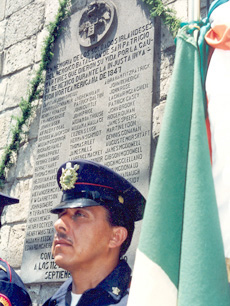
|  |  |  News Around the Republic of Mexico News Around the Republic of Mexico  
The San Patricios: Mexico’s Fighting Irish
 Mark R. Day - laprensa-sandiego.org Mark R. Day - laprensa-sandiego.org
go to original
March 13, 2010


| | A monument in Mexico honoring the Irish |  |
In 1846, thousands of immigrants, mostly Irish, joined the US army and were sent with Gen. Zachary Taylor’s army to invade Mexico in what some historians have called a war of Manifest Destiny.

Dubious about why they were fighting a Catholic country, and fed up with mistreatment from their Anglo-Protestant officers, hundreds of Irish and other immigrants deserted Taylor’s army and joined forces with Mexico. Led by Captain John Riley of County Galway, they called themselves the St. Patrick’s Battalion — in Spanish, the San Patricios.

They fought bravely in most of the campaigns of the two-year conflict, but their efforts failed to stem the yankee onslaught. Soon the US Army occupied the halls of Montezuma, and Mexico eventually surrendered, ceding nearly half its territory to the United States.

Toward the end of the conflict, at the Battle of Churubsco, 83 San Patricios were captured, and 72 were court martialed. Of this number, 50 were sentenced to be hanged and 16 were flogged and branded on their cheeks with the letter “D” for deserter.

To this day, many US historians regard these men as traitors, but Mexicans see them as heroes, honoring them every Sept. 12 with a special commenoration. In 1993, the Irish began their own ceremony to honor them in Clifden, Galway, Riley’s hometown.

Some historians, relying on court martial testimony, portray the San Patricios as confused and bewildered young men who drank heavily and later regretted their choices. Other analysts wonder what could have motivated a group of drunken adventurers to don the enemy’s uniform and fight to the death.

“The San Patricios were alienated both from American society as well as the US Army,” says Professor Kirby Miller of the University of Missour, an expert on Irish immigration. “They realized that the army was not fighting a war of liberty, but one of conquest against fellow Catholics such as themselves.”

Riley has hardly an unfocused rebel. As an Irishman and Catholic he was undoubtedly appalled and shocked at the behavior of the Texas Rangers and other volunteers who Gen. Taylor admittedly could not control. Among their crimes were murder, rape, robbery and the desecration of Catholic churches.

While held prisoner in Mexico City, Riley wrote to a friend in Michigan: “Be not deceived by a nation that is at war with Mexico, for a friendlier and more hospitable people than the Mexicans there exists not on the face of the earth.”

Riley’s attitude could serve as a role model in today’s multicultural society. In fact, the parallels between the Irish immigrants of the 1840’s and today’s newcomers from Mexico and Central America should be obvious. Historically, both groups have suffered domination from oppressors who sought to destroy their religion and culture.

Both groups have braved dangerous journeys to arrive in America. The Irish crossed rough seas in “coffin ships” laden with diseased and starving passengers, while their Latin counterparts continue to brave barren deserts and freezing mountains, not to mention the barbs of nativists who see them as economic and cultural threats to the so-called “character of America.”

Mark R. Day is a journalist and documentary film maker. He is the author of Forty Acres: Cesar Chavez and the Farm Workers (Praeger, 1971)
|

 |
|  |



